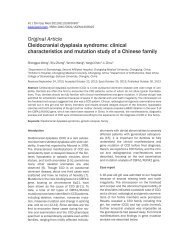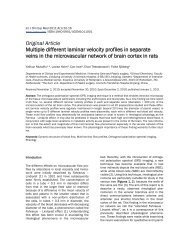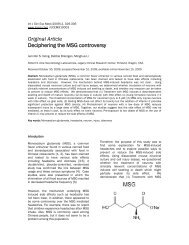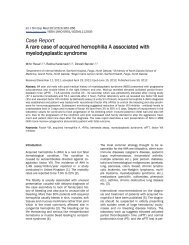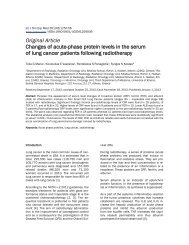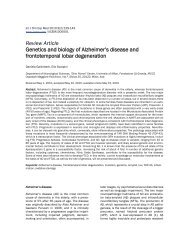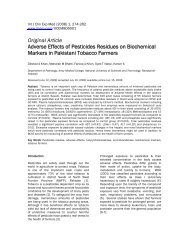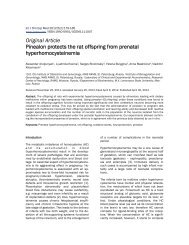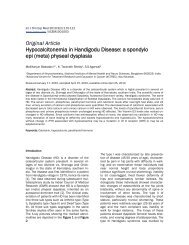Role of myeloid-specific G-protein coupled receptor kinase-2 in sepsis
Role of myeloid-specific G-protein coupled receptor kinase-2 in sepsis
Role of myeloid-specific G-protein coupled receptor kinase-2 in sepsis
You also want an ePaper? Increase the reach of your titles
YUMPU automatically turns print PDFs into web optimized ePapers that Google loves.
Myeloid-<strong>specific</strong> G-<strong>prote<strong>in</strong></strong> <strong>coupled</strong> <strong>receptor</strong> <strong>k<strong>in</strong>ase</strong>-2 <strong>in</strong> <strong>sepsis</strong><br />
[21] Rittirsch D, Hoesel LM, Ward PA. The disconnect<br />
between animal models <strong>of</strong> <strong>sepsis</strong> and<br />
human <strong>sepsis</strong>. J Leukoc Biol 2007; 81: 137-<br />
143.<br />
[22] Remick DG, Ward PA. Evaluation <strong>of</strong> endotox<strong>in</strong><br />
models for the study <strong>of</strong> <strong>sepsis</strong>. Shock 2005; 24<br />
Suppl 1: 7-11.<br />
[23] Clausen BE, Burkhardt C, Reith W, Renkawitz R,<br />
Forster I. Conditional gene target<strong>in</strong>g <strong>in</strong> macrophages<br />
and granulocytes us<strong>in</strong>g LysMcre mice.<br />
Transgenic Res 1999; 8: 265-277.<br />
[24] Matkovich SJ, Diwan A, Klanke JL, Hammer DJ,<br />
Marreez Y, Odley AM, Brunskill EW, Koch WJ,<br />
Schwartz RJ, Dorn GW 2nd. Cardiac-<strong>specific</strong><br />
ablation <strong>of</strong> G-<strong>prote<strong>in</strong></strong> <strong>receptor</strong> <strong>k<strong>in</strong>ase</strong> 2 redef<strong>in</strong>es<br />
its roles <strong>in</strong> heart development and betaadrenergic<br />
signal<strong>in</strong>g. Circ Res 2006; 99: 996-<br />
1003.<br />
[25] Hubbard WJ, Choudhry M, Schwacha MG, Kerby<br />
JD, Rue LW 3rd, Bland KI, Chaudry IH. Cecal<br />
ligation and puncture. Shock 2005; 24 Suppl 1:<br />
52-57.<br />
[26] McMaken S, Exl<strong>in</strong>e MC, Mehta P, Piper M,<br />
Wang Y, Fischer SN, Newland CA, Schrader CA,<br />
Balser SR, Sarkar A, Baran CP, Marsh CB, Cook<br />
CH, Phillips GS, Ali NA. Thrombospond<strong>in</strong>-1 contributes<br />
to mortality <strong>in</strong> mur<strong>in</strong>e <strong>sepsis</strong> through<br />
effects on <strong>in</strong>nate immunity. PLoS One 2011; 6:<br />
e19654.<br />
[27] Porter KJ, Gonipeta B, Parvataneni S, Appledorn<br />
DM, Patial S, Sharma D, Gangur V, Amalfitano<br />
A, Parameswaran N. Regulation <strong>of</strong><br />
lipopolysaccharide-<strong>in</strong>duced <strong>in</strong>flammatory response<br />
and endotoxemia by β-arrest<strong>in</strong>s. J Cell<br />
Physiol 2010; 225: 406-416.<br />
[28] Coimbra R, Melbostad H, Loomis W, Tobar M,<br />
Hoyt DB. Phosphodiesterase <strong>in</strong>hibition decreases<br />
nuclear factor-κB activation and shifts<br />
the cytok<strong>in</strong>e response toward anti-<strong>in</strong>flammatory<br />
activity <strong>in</strong> acute endotoxemia. J Trauma 2005;<br />
59: 575-582.<br />
[29] Loisa P, R<strong>in</strong>ne T, La<strong>in</strong>e S, Hurme M, Kauk<strong>in</strong>en<br />
S. Anti-<strong>in</strong>flammatory cytok<strong>in</strong>e response and the<br />
development <strong>of</strong> multiple organ failure <strong>in</strong> severe<br />
<strong>sepsis</strong>. Acta Anaesthesiol Scand 2003; 47: 319<br />
-325.<br />
[30] Osuchowski MF, Connett J, Welch K, Granger J,<br />
Remick DG. Stratification is the key: <strong>in</strong>flammatory<br />
biomarkers accurately direct immunomodulatory<br />
therapy <strong>in</strong> experimental <strong>sepsis</strong>. Crit<br />
Care Med 2009; 37: 1567-1573.<br />
[31] Rittirsch D, Flierl MA, Ward PA. Harmful molecular<br />
mechanisms <strong>in</strong> <strong>sepsis</strong>. Nat Rev Immunol<br />
2008; 8: 776-787.<br />
[32] Stearns Kurosawa DJ, Osuchowski MF, Valent<strong>in</strong>e<br />
C, Kurosawa S, Remick DG. The pathogenesis<br />
<strong>of</strong> <strong>sepsis</strong>. Annu Rev Pathol 2011; 6: 19<br />
-48.<br />
[33] Peppel K, Zhang L, Huynh TT, Huang X, Jacobson<br />
A, Brian L, Exum ST, Hagen PO, Freedman<br />
NJ. Overexpression <strong>of</strong> G <strong>prote<strong>in</strong></strong>-<strong>coupled</strong> <strong>receptor</strong><br />
<strong>k<strong>in</strong>ase</strong>-2 <strong>in</strong> smooth muscle cells reduces<br />
neo<strong>in</strong>timal hyperplasia. J Mol Cell Cardiol 2002;<br />
34: 1399-1409.<br />
[34] Hestdal K, Ruscetti FW, Ihle JN, Jacobsen SE,<br />
Dubois CM, Kopp WC, Longo DL, Keller JR.<br />
Characterization and regulation <strong>of</strong> RB6-8C5<br />
antigen expression on mur<strong>in</strong>e bone marrow<br />
cells. J Immunol 1991; 147: 22-28.<br />
[35] Turnbull IR, Wlzorek JJ, Osborne D, Hotchkiss<br />
RS, Coopersmith CM, Buchman TG. Effects <strong>of</strong><br />
age on mortality and antibiotic efficacy <strong>in</strong> cecal<br />
ligation and puncture. Shock 2003; 19: 310-<br />
313.<br />
[36] Nijboer CH, Heijnen CJ, Willemen HL, Groenendaal<br />
F, Dorn GW 2nd, van Bel F, Kavelaars A.<br />
Cell-<strong>specific</strong> roles <strong>of</strong> GRK2 <strong>in</strong> onset and severity<br />
<strong>of</strong> hypoxic-ischemic bra<strong>in</strong> damage <strong>in</strong> neonatal<br />
mice. Bra<strong>in</strong> Behav Immun 2010; 24: 420-426.<br />
[37] Aragay AM, Mellado M, Frade JM, Mart<strong>in</strong> AM,<br />
Jimenez Sa<strong>in</strong>z MC, Mart<strong>in</strong>ez AC, Mayor F Jr.<br />
Monocyte chemoattractant <strong>prote<strong>in</strong></strong>-1-<strong>in</strong>duced<br />
CCR2B <strong>receptor</strong> desensitization mediated by<br />
the G <strong>prote<strong>in</strong></strong>-<strong>coupled</strong> <strong>receptor</strong> <strong>k<strong>in</strong>ase</strong> 2. Proc<br />
Natl Acad Sci USA 1998; 95: 2985-2990.<br />
[38] Oppermann M, Mack M, Proudfoot AE, Olbrich<br />
H. Differential effects <strong>of</strong> CC chemok<strong>in</strong>es on CC<br />
chemok<strong>in</strong>e <strong>receptor</strong> 5 (CCR5) phosphorylation<br />
and identification <strong>of</strong> phosphorylation sites on<br />
the CCR5 carboxyl term<strong>in</strong>us. J Biol Chem 1999;<br />
274: 8875-8885.<br />
[39] Busillo JM, Armando S, Sengupta R, Meucci O,<br />
Bouvier M, Benovic JL. Site-<strong>specific</strong> phosphorylation<br />
<strong>of</strong> CXCR4 is dynamically regulated by<br />
multiple <strong>k<strong>in</strong>ase</strong>s and results <strong>in</strong> differential<br />
modulation <strong>of</strong> CXCR4 signal<strong>in</strong>g. J Biol Chem<br />
2010; 285: 7805-7817.<br />
[40] Penela P, Ribas C, Aymerich I, Mayor F Jr. New<br />
roles <strong>of</strong> G <strong>prote<strong>in</strong></strong>-<strong>coupled</strong> <strong>receptor</strong> <strong>k<strong>in</strong>ase</strong> 2<br />
(GRK2) <strong>in</strong> cell migration. Cell Adh Migr 2009; 3:<br />
19-23.<br />
[41] Alves Filho JC, Sonego F, Souto FO, Freitas A,<br />
Verri WA Jr, Auxiliadora Mart<strong>in</strong>s M, Basile Filho<br />
A, McKenzie AN, Xu D, Cunha FQ, Liew FY. Interleuk<strong>in</strong>-33<br />
attenuates <strong>sepsis</strong> by enhanc<strong>in</strong>g neutrophil<br />
<strong>in</strong>flux to the site <strong>of</strong> <strong>in</strong>fection. Nat Med<br />
2010; 16: 708-712.<br />
[42] Tarrant TK, Rampersad RR, Esserman D, Rothle<strong>in</strong><br />
LR, Liu P, Premont RT, Lefkowitz RJ, Lee<br />
DM, Patel DD. Granulocyte chemotaxis and<br />
disease expression are differentially regulated<br />
by GRK subtype <strong>in</strong> an acute <strong>in</strong>flammatory arthritis<br />
model (K/BxN). Cl<strong>in</strong> Immunol 2008; 129:<br />
115-122.<br />
[43] Craciun FL, Schuller ER, Remick DG. Early enhanced<br />
local neutrophil recruitment <strong>in</strong> peritonitis-<strong>in</strong>duced<br />
<strong>sepsis</strong> improves bacterial clearance<br />
and survival. J Immunol 2010; 185: 6930-<br />
6938.<br />
[44] Riedemann NC, Neff TA, Guo RF, Bernacki KD,<br />
Laudes IJ, Sarma JV, Lambris JD, Ward PA.<br />
Protective effects <strong>of</strong> IL-6 blockade <strong>in</strong> <strong>sepsis</strong> are<br />
l<strong>in</strong>ked to reduced C5a <strong>receptor</strong> expression. J<br />
Immunol 2003; 170: 503-507.<br />
329 Int J Cl<strong>in</strong> Exp Med 2011;4(4):320-330



